“If you really want to understand a place, step into its temples- that’s where the stories live.”
Temples aren’t just buildings- they’re a window into the soul of a culture. Visiting the Land of Smiles is incomplete without visiting the best Thailand temples. When you’re travelling, it’s easy to get caught up in the street food, the beaches, and the shopping. But if you want to truly connect with a destination, exploring a temple is one of the most meaningful things you can do.
They tell you about the beliefs, the history, and the way of life that’s shaped the people there. Now, if you’re going on vacation, visiting Thailand’s temples is a must.
These aren’t your average temples. There’s something incredibly special about them. From the glittering gold details to the peaceful atmosphere, every ‘Wat’ has its own story. They are often bright and lively, showing both energy and calm moments at the same time.
You might hear monks chanting softly, see locals making offerings, or simply find a moment to breathe and take it all in.
What makes Thai Wats different from other temples worldwide is how they combine beauty with daily life. They’re not just tourist spots; they’re part of the everyday rhythm for many Thai people.
Visiting one isn’t just about taking photos- it’s about getting into something deeply spiritual and uniquely Thai.
So, whether you’re wandering through the heart of Bangkok or exploring a quiet town up north, don’t miss the chance to visit the best temples in Thailand. It could be the most peaceful and eye-opening part of your whole trip.
Tip: Learning common Thai phrases will be helpful for you to interact with people. So, take note of some.
List of the Best Temples in Thailand You Must Visit
The list of the best temples in Thailand is never-ending. So, take note of the famous Buddha temples in Thailand to attain ultimate peace.
Best Thailand Temples in Bangkok and Central Thailand
Temples in Bangkok and Central Thailand have beautiful designs, colourful murals, and calm Buddha statues that create a peaceful atmosphere.
Each temple has its own unique style. Some sit by rivers, reflecting softly on the water, while others have tall golden spires that shine in the sunlight. You can find quiet spots for reflection, busy areas where local people pray, and lively festivals that bring energy and colour.
Wat Phra Kaew, Bangkok
Temple of the Emerald Buddha, or the Wat Phra Kaew, is one of those places that truly takes your breath away when you step inside. Set within the Grand Palace complex, it’s home to the highly revered Emerald Buddha, a small yet sacred statue carved from a single block of jade.
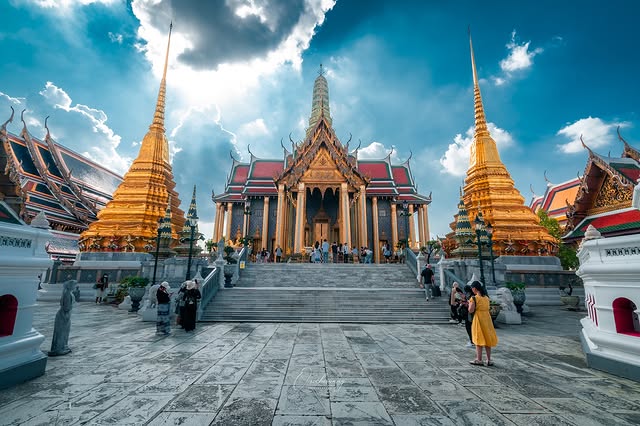
What’s impressive is that the statue’s robes are changed with the seasons by the King himself, no less!
The temple grounds are dazzling with golden spires, colourful murals, and mythical statues at every turn. Every detail here feels like it has a story to tell.
Timings: 8:30 AM to 3:30 PM
Entry Fee: 500 THB (includes Grand Palace entry)
Tips: Dress modestly- shoulders and knees covered. They’re quite strict about it. Renting a sarong at the entrance will be a nice option. Don’t rush through- take your time to enjoy the peace. It’s worth every moment.
Wat Pho, Bangkok
Temple of the Reclining Buddha or Wat Pho is one of those places where you walk in and just go “wow.” It’s famous for its massive Reclining Buddha (15 metres high and 46 metres long), completely covered in gold leaf. The Buddha’s serene smile and the mother-of-pearl inlays on his feet are just something else.
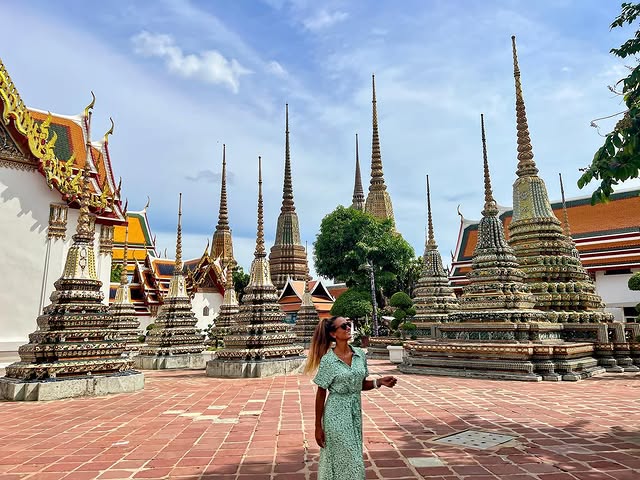
But Wat Pho is more than just that statue. It is known as the birthplace of Thai massage. You’ll find peaceful courtyards, intricate murals, and rows of golden Buddhas that feel almost endless.
Timings: 8:00 AM to 6:30 PM
Entry Fee: 200 THB
Tips: Wear comfy shoes you can slip off easily- you’ll take them on and off. Don’t miss the traditional Thai massage school inside for an authentic experience!
Wat Arun, Bangkok
Temple of Dawn or Wat Arun is a famous temple in Bangkok by the Chao Phraya River, showcasing beauty at sunrise and sunset. The central prang (a tall tower) is beautifully decorated with pieces of colourful porcelain, which sparkle in the sunlight and make the whole temple look like it’s glowing.

You can actually climb partway up the central prang for some incredible views of the river and the city skyline- worth the steps! The temple’s design is different from many others in Thailand, giving it a slightly Khmer feel.
Timings: 8:00 AM to 6:00 PM
Entry Fee: 100 THB
Tips: The best time to visit is early morning or just before sunset for softer light and fewer crowds. Wear good walking shoes- the steps are steep and narrow.
Wat Saket (Golden Mount), Bangkok
Wat Saket, also known as the Golden Mount, is one of Bangkok’s most peaceful escapes, right in the middle of the city. What makes it special is its golden chedi perched on top of an artificial hill, which you reach by climbing around 300 gentle steps that spiral up through shaded gardens and little bells that ring in the breeze.
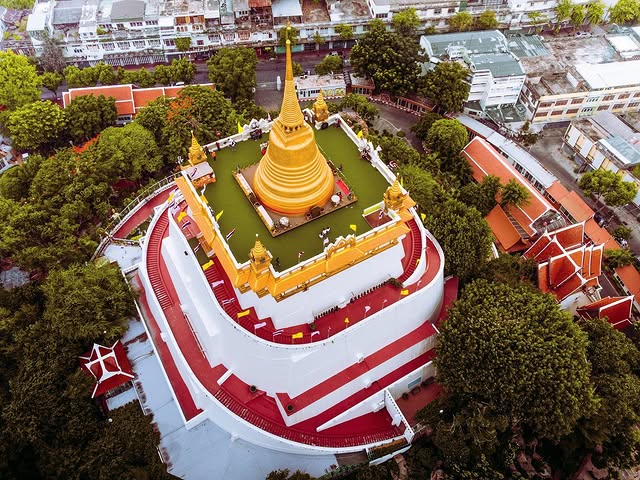
The walk is worth it for the view from the top. You’ll get a stunning 360-degree look at the city’s rooftops and skyline. It’s especially lovely around sunset.
The temple has a rich history dating back to the Ayutthaya period, and it’s home to a relic of the Buddha said to have been brought from India.
Timings: 7:00 AM to 7:00 PM
Entry Fee: 100 THB
Tips: Bring water and visit early or late in the day to avoid the heat. The climb is easy, but it can get warm!
Note: If you are interested in learning about the history of the Ayutthaya period, then visiting historical sites, which include some UNESCO World Heritage Sites in Thailand, is a must.
Wat Suthat, Bangkok
Wat Suthat often flies under the radar, but it’s honestly one of Bangkok’s most underrated temples. It’s not far from the Grand Palace, yet it’s far quieter, which makes for a much more relaxed visit.

The temple is known for its impressive red Giant Swing standing tall right outside. It used to be part of a religious ceremony (now discontinued), but it still makes for a striking photo spot.
Inside, the main hall is massive and houses a majestic 13th-century bronze Buddha, one of the oldest in Thailand. The walls are covered with detailed murals that tell stories from Buddhist scriptures- they’re beautifully done and worth taking your time with.
Timings: 8:30 AM to 9:00 PM
Entry Fee: 100 THB
Tips: It’s usually quiet, so it’s perfect if you want to escape the crowds. Bring socks, as shoes must come off before entering the main hall.
Best Thailand Temples in Northern Thailand
What makes Northern temples, especially the temples in Thailand’s Chiang Mai, stand out is their unique style. Many feature elegant wooden carvings, colourful Lanna architecture, and detailed murals that tell stories from centuries ago.
Some temples sit high on hills, giving you stunning views after an easy climb. Others have peaceful courtyards where monks follow their daily routines, showing you the calm pace of monastic life.
Apart from temples, Northern Thailand is known for ethical elephant sanctuaries, which you must visit to learn about the importance of elephant conservation and the efforts being made to protect these magnificent creatures in their natural habitat.
Wat Phra That Doi Suthep, Chiang Ma
Wat Phra That Doi Suthep is one of Chiang Mai’s most iconic landmarks- and honestly, no trip to the north feels complete without seeing it. The temple sits high on a mountain and looks over the city. The golden chedi at the centre glistens beautifully in the sunlight, and the entire complex feels peaceful and spiritual.
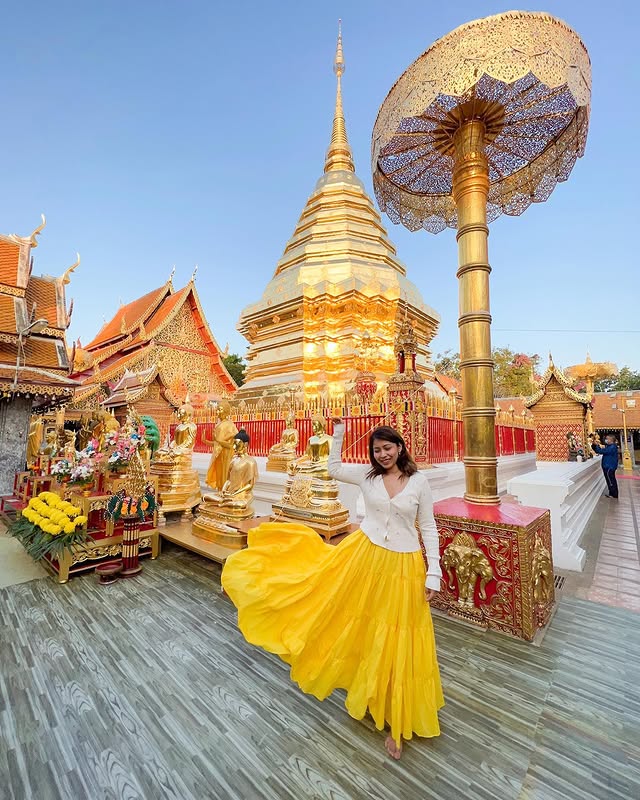
According to legend, the site was chosen by a sacred white elephant carrying a relic of the Buddha. It stopped here, trumpeted three times, and passed away, marking the spot as holy.
To get there, you’ll climb a 306-step staircase flanked by Naga serpents- or you can take a quick tram ride up.
Timings: 6:00 AM to 8:00 PM
Entry Fee: 30 THB (extra for tram)
Tips: Bring a light jacket- it’s cooler up the mountain. Mornings are calm and great for thinking.
Wat Chedi Luang, Chiang Mai
Wat Chedi Luang is in the centre of Chiang Mai’s Old City and really captivates you. The massive chedi (stupa) that gives the temple its name was once the tallest structure in ancient Chiang Mai, built in the 14th century. Though partially ruined by an earthquake in the 1500s, it still stands tall and majestic, with ancient stone elephants guarding its base.
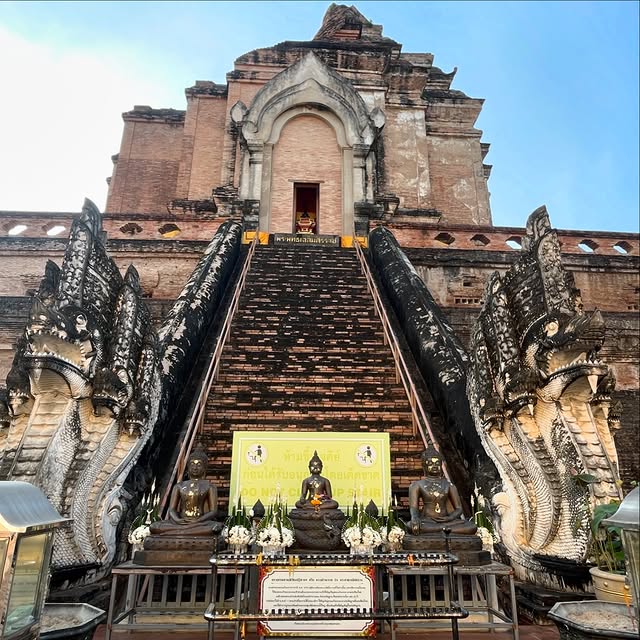
The temple has a sacred feel, especially around sunset when golden light hits the old bricks. It was once home to the Emerald Buddha (now in Bangkok), and that history adds a layer of reverence.
Timings: 6:00 AM to 6:00 PM
Entry Fee: 50 THB
Tips: Don’t miss the monk chat sessions- real conversations with monks, open to anyone curious about Buddhism.
Wat Phra Singh, Chiang Mai
Wat Phra Singh is one of Chiang Mai’s most celebrated temples, and it’s easy to see why. Located right in the heart of the Old City, this temple is a beautiful blend of history, art, and everyday spirituality. The star attraction here is the Phra Singh Buddha, housed in a stunning chapel called the Viharn Lai Kham, known for its elegant Lanna-style architecture and detailed gold stencilling.

The temple dates back to the 14th century and has long been a centre for learning and community gatherings. It’s especially lively during Songkran (Thai New Year), when locals come to pour water over the Buddha for blessings.
Timings: 6:00 AM to 5:00 PM
Entry Fee: 40 THB
Tips: Visit in the morning for a more peaceful experience, and don’t miss the beautifully carved wooden doors- they’re little works of art.
Wat Rong Khun, Chiang Rai
White Temple or Wat Rong Khun isn’t your typical Thai temple- it’s more like walking into a dream. This all-white artwork was created by local artist Chalermchai Kositpipat. It combines traditional Buddhist symbols with modern, surreal art.
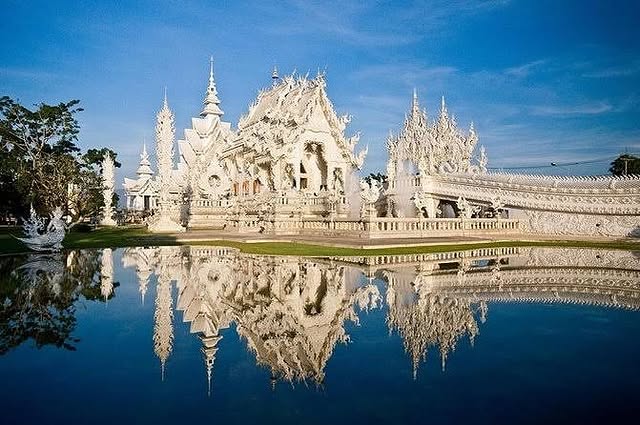
The entire structure sparkles under the sun thanks to thousands of tiny mirrored glass pieces mixed into the white plaster. It’s unlike anything else in Thailand.
To enter the temple, you’ll walk across a bridge over a sea of outreached hands, symbolising human desire and the path to enlightenment.
Inside, you’ll find unexpected murals featuring everything from superheroes to spaceships, mixed with spiritual imagery. It’s strange, thought-provoking, and absolutely unforgettable.
Timings: 8:00 AM to 5:00 PM
Entry Fee: 100 THB
Tips: Dress respectfully, even though it feels more like an art gallery than a temple. Try to arrive early- it’s very popular and can get crowded fast.
Wat Rong Suea Ten (Blue Temple), Chiang Rai
Wat Rong Suea Ten, known as the Blue Temple, is a beautiful place to visit. It has a bright blue colour with gold details, giving it a stunning look. The name means “House of the Dancing Tiger.” This temple was once home to wild tigers that lived in the area.
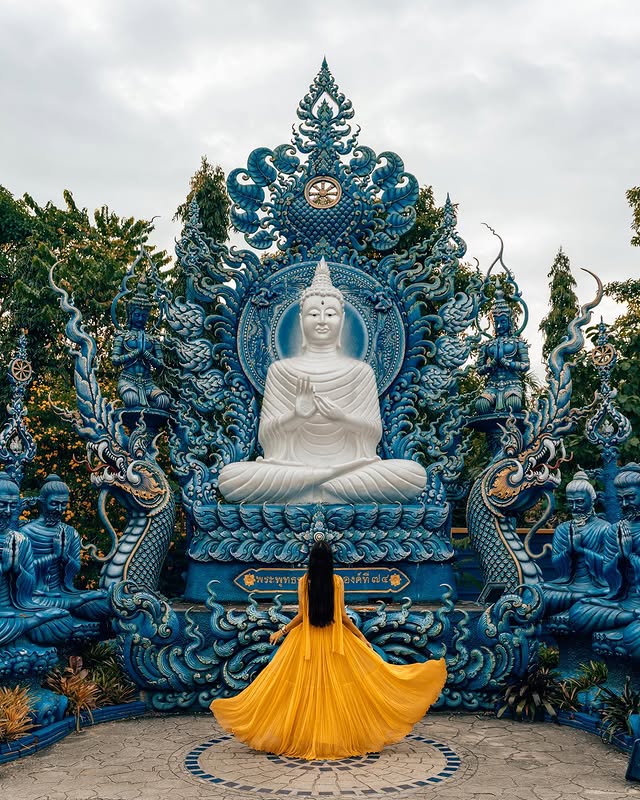
The Blue Temple was created by a student of Chalermchai Kositpipat, who is the artist behind the White Temple. It combines traditional Thai design with a modern touch. Inside, a striking white Buddha sits peacefully, surrounded by glowing blue walls and celestial murals that seem to shimmer.
Timings: 7:00 AM to 8:00 PM
Entry Fee: Free (donations welcome)
Tips: Go late afternoon for more soothing light and less crowds. Don’t forget to explore the surrounding grounds- there are unique statues hidden throughout.
Wat Phra That Lampang Luang, Lampang
Wat Phra That Lampang Luang is one of northern Thailand’s hidden gems, showcasing a stunning example of Lanna architecture and standing as one of the oldest wooden temples still in existence.
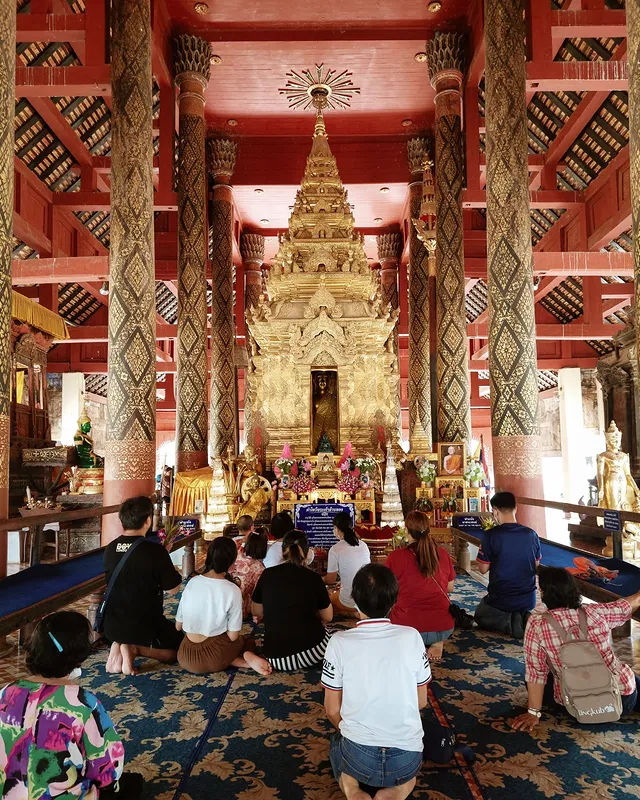
Conveniently located just outside Lampang town, this sacred site exudes a sense of peace and is steeped in tradition. The main chedi is believed to house a relic of the Buddha, making it an important pilgrimage destination.
Visitors can admire the beautiful wooden structures, ancient murals, and a serene courtyard that feels a world apart from the hustle and bustle of modern life. It is thought that the temple was founded in the 13th century, and much of its original character has been lovingly preserved.
Timings: 7:30 AM to 5:00 PM
Entry Fee: Free
Tips: Be sure to visit the camera obscura room- on sunny days, it projects a live image of the chedi onto a white wall using just a pinhole of light!
Best Thailand Temples in Northeastern Thailand (Isaan)
If you find yourself exploring Northeastern Thailand, also known as Isaan, the temples’ architecture here often blends traditional Thai styles with local influences, and you might come across beautiful colourful decorations made from glass mosaics and intricate stucco work. Many temples sit amidst peaceful rural landscapes, surrounded by rice fields and small villages, giving you a genuine sense of everyday life in Isaan.
Wat Phra That Phanom- Nakhon Phanom
Wat Phra That Lampang Luang is one of northern Thailand’s hidden gems- a stunning example of Lanna architecture and one of the oldest wooden temples still standing. Located just outside Lampang town, this sacred site feels peaceful and deeply rooted in tradition.
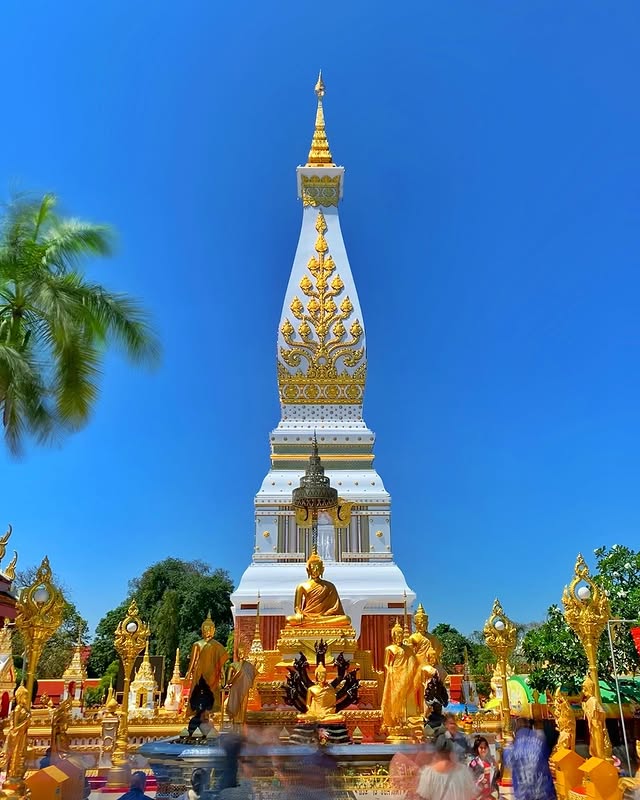
The main chedi is said to house a relic of the Buddha, making it an important pilgrimage spot. You’ll also find beautiful wooden structures, ancient murals, and a calm courtyard that feels worlds away from the bustle of modern life. It’s believed that the temple was founded in the 13th century, and much of its original character has been beautifully preserved.
Timings: 7:30 AM to 5:00 PM
Entry Fee: Free (donations appreciated)
Tips: Don’t miss the camera obscura room on sunny days, it projects a live image of the chedi onto a white wall using just a pinhole of light!
Wat Pa Maha Chedi Kaew (Temple of a Million Bottles), Sisaket
Located in northeast Thailand, Wat Pa Maha Chedi Kaew is a unique temple like no other. Locals call it the “Temple of a Million Bottles”- and that’s no exaggeration.
The monks built the entire temple complex using over a million recycled glass bottles, mostly green and brown ones. It’s their creative way of turning waste into something beautiful and meaningful.
What’s incredible is how detailed everything is. The main chedi, prayer halls, and even the toilets are all made from bottles, neatly stacked with impressive precision. The bottle caps are used as colourful mosaic tiles to create intricate designs.
Timings: 8:00 AM to 5:00 PM
Entry Fee: Free (but donations are appreciated)
Tips: It’s best to visit in the morning when the light hits the glass beautifully.
Best Thailand Temples in Southern Thailand
Visiting temples in Southern Thailand shows the area’s rich cultural mix, including influences from Malay and Chinese traditions along with traditional Thai styles.
The buildings often feature colourful roof tiles and detailed carvings. Inside, you’ll find peaceful Buddha statues that encourage quiet reflection. Some temples are small and cosy, providing a calm retreat, while others are larger complexes where you can experience local spiritual life.
Wat Phra Mahathat Woramahawihan, Nakhon Si Thammarat
Wat Phra Mahathat Woramahawihan is one of those temples that feels truly timeless. Located in the southern city of Nakhon Si Thammarat, it’s one of Thailand’s most respected religious sites- and it’s been standing strong since the 13th century!

The main stupa, which towers above the grounds, is said to enshrine a relic of the Buddha, making it an essential place of pilgrimage.
The architecture has a Sri Lankan touch, and the tall, white chedi with its golden spire is absolutely stunning, especially when the sunlight hits just right. Walk around and you’ll find peaceful courtyards, ancient Buddha statues, and even a sacred Bodhi tree believed to be linked to the original in India.
Timings: 6:00 AM to 6:00 PM
Entry Fee: Free (donations are welcome)
Tips: It’s a great place to visit early in the morning- cooler weather, quieter atmosphere, and the monks are often around for morning chants.
Wat Tham Sua (Tiger Cave Temple), Krabi
If you’re up for a bit of a challenge with a big reward, Wat Tham Sua in Krabi should be on your list. Known as the Tiger Cave Temple, it comes from a tiger-shaped rock formation and stories of tigers once roaming the area.
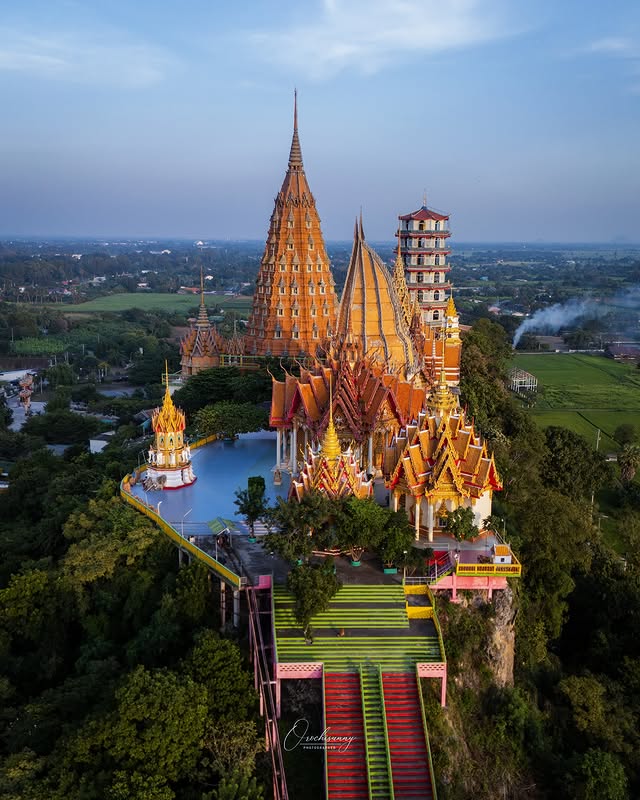
But today, it’s more famous for its jaw-dropping viewpoint- after you’ve conquered the 1,260 steps to the top!
Yes, it’s a serious climb (you’ll definitely feel it in your legs), but once you reach the summit, you’ll find a peaceful golden Buddha and sweeping views over lush forest and limestone cliffs. It’s the blessing that you get here in the south.
Timings: 6:00 AM to 6:00 PM
Entry Fee: Free (donations welcome)
Tips: Start early to avoid the heat and bring water! Wear comfy shoes and modest clothing- shoulders and knees should be covered.
Best Thailand Temples in Western & Eastern Thailand
When exploring temples in Western Thailand, many temples have a rustic feel, with traditional wooden structures and simple but beautiful decorations.
In Eastern Thailand, you might find temples near coastal areas or small towns, where the atmosphere is friendly and welcoming.
Both regions highlight the local way of life, with monks often seen going about their daily routines and communities gathering for festivals and ceremonies.
Wat Tham Khao Noi and Wat Tham Sua, Kanchanaburi
These two neighbouring temples in Kanchanaburi are a real treat for both the eyes and the soul. Set on a hilltop surrounded by rice fields, Wat Tham Khao Noi and Wat Tham Sua offer totally different vibes- but together, they make for a magical visit.
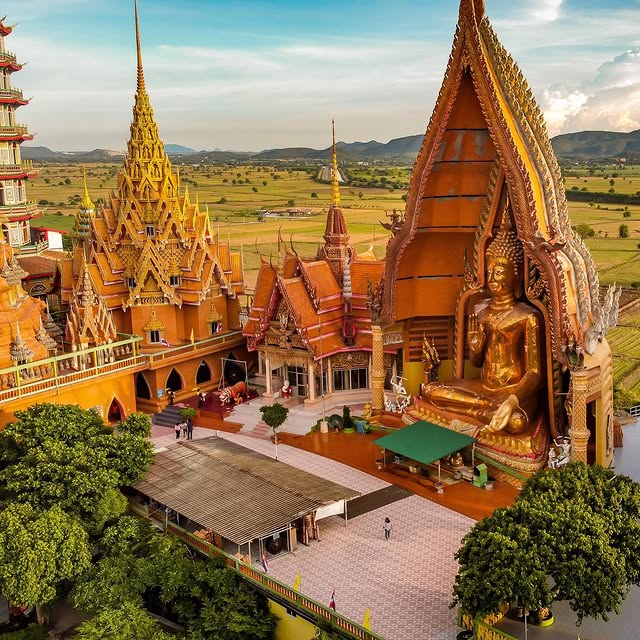
Wat Tham Khao Noi has a strong Chinese influence, with a colourful multi-tiered pagoda and dragon-adorned steps. Climb to the top and you’ll get sweeping views of the green countryside- it’s absolutely stunning.
Right next door, Wat Tham Sua (not to be confused with the one in Krabi!) is famous for its towering golden Buddha statue and beautiful orange-hued architecture. The name means “Tiger Cave Temple” and comes from a local legend that tigers once roamed these hills.
Timings: 8:00 AM to 5:00 PM
Entry Fee: Free (donations welcome)
Tips: Bring water, wear comfy shoes for the stairs, and dress respectfully- shoulders and knees covered.
Wat Pa Phu Kon, Udon Thani
If you’re looking for a peaceful spot away from the usual tourist trails, Wat Pa Phu Kon in Udon Thani is a real find. Nestled in the hills surrounded by forest, this temple feels like a calming retreat. It’s sometimes called the “Blue Temple” because of its beautiful turquoise roof that stands out against the greenery.

Inside, you’ll see an impressive reclining Buddha statue made from white marble imported all the way from Italy. It’s huge and incredibly serene, a perfect place to pause and reflect. The walls around the temple are decorated with colourful murals that tell stories from Buddhist teachings.
Nearby, a golden stupa stands tall. It is a place where people believe sacred relics are kept. You can climb up for some lovely views of the forest.
Timings: 8:30 AM to 5:00 PM
Entry Fee: Free (donations are welcome)
Tips: Visit in the morning when it is quiet. The forest trails nearby are lovely for a peaceful stroll.
Unique and Architecturally Distinct Temples in Thailand
Thailand is home to unique temples that defy traditional designs, showcasing bold creativity and striking details. Some combine modern art with ancient symbolism, featuring bright mosaics, mirrored glass, or intricate sculptures.
You’ll encounter temples shaped like mythical creatures, spiralling towers with dragons, and structures resembling giant boats or animals. These temples provide a fresh perspective on Thai culture and religion, making your visits memorable and inspiring.
Sanctuary of Truth, Pattaya
If you visit Pattaya, be sure to see the Sanctuary of Truth. It’s a huge, stunning wooden temple right by the sea, unlike any other place you’ll find in Thailand.
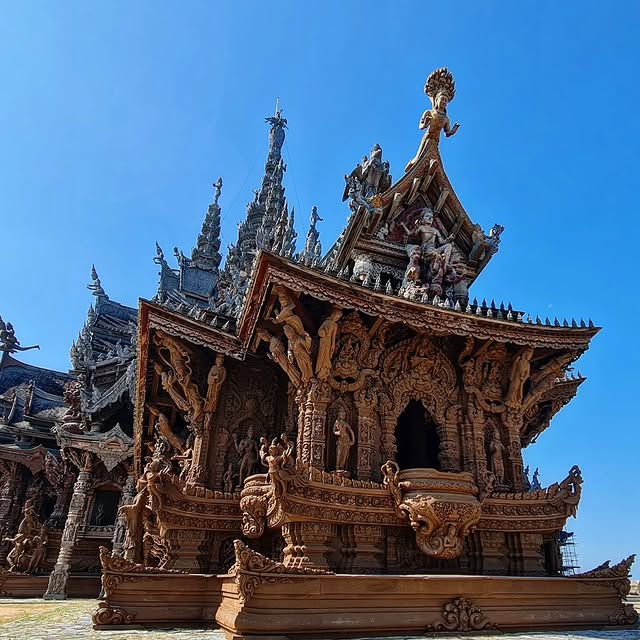
What’s really amazing is that the entire building is made from wood- no metal nails at all and its covered head to toe with intricate carvings of figures from Buddhist and Hindu myths. That’s the reason this place is listed among one of the best things to do in Thailand.
The sanctuary isn’t just about its beautiful architecture; it’s also about exploring deeper ideas like the connection between humans, nature, and the universe.
The craftsmanship is mind-blowing, and if you take a guided tour, you’ll discover the meaning behind each carving, which makes the visit even more special.
Timings: 8:00 AM to 6:00 PM
Entry Fee: Around 500 Baht for adults, with discounts for kids under 110 cm
Tips: Dress respectfully (cover your shoulders and knees) and wear comfy shoes- there’s plenty to walk around. Going with a guide helps you get the most from these unique spots.
Wat Samphran (Dragon Temple), Nakhon Pathom
If you want to see something truly different near Bangkok, Wat Samphran—better known as the Dragon Temple- is definitely worth a visit. This quirky temple is famous for its tall, pink tower wrapped by a gigantic green dragon that twists all the way up to the top. It’s quite the sight and makes for some fantastic photos!
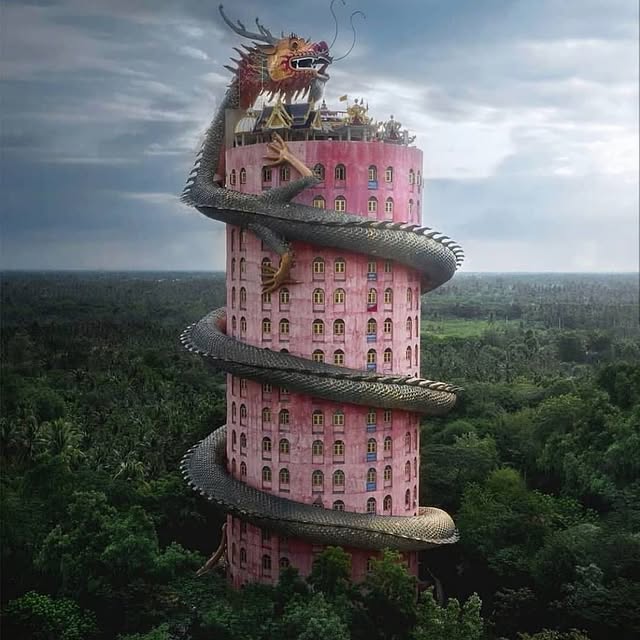
Inside the dragon’s body is a spiralling staircase you can climb for great views over the surrounding countryside. The temple itself houses a large Buddha statue and a collection of other interesting sculptures, including symbols of luck and wisdom like a rabbit and a turtle.
Built in the late 1970s by a monk with a creative vision, the temple combines Buddhist beliefs with local folklore, and the dragon represents power and protection.
Timings: 6:00 AM to 6:00 PM
Entry Fee: Free (but donations are appreciated)
Tips: Try to visit early or late in the day to avoid the midday heat, wear comfy shoes, and cover your shoulders and knees out of respect.
Wat Yannawa (Boat Temple)
If you want to see something truly unique in the heart of Bangkok, Wat Yannawa—better known as the Boat Temple- is definitely worth a visit. This distinctive temple is shaped like a Chinese junk boat, complete with masts and deck details, setting it apart from traditional Thai temple architecture. It’s an eye-catching blend of faith and maritime heritage that makes for memorable photos!

The boat-shaped structure symbolises the journey toward enlightenment and was commissioned by King Rama III to encourage maritime trade and commemorate Thailand’s seafaring past. Inside the temple, you’ll find relics of the Buddha and beautiful altars adorned with golden statues and incense offerings. The tranquil atmosphere makes it a peaceful spot to reflect and explore.
Timings: 8:00 AM to 6:00 PM
Entry Fee: Free (but donations are appreciated)
Tips: Go in the morning or late afternoon for a cooler, quieter experience. Be respectful- cover your shoulders and knees, and remove shoes before entering temple buildings.
Conclusion
Thailand’s temples are not just about beautiful buildings- they show the country’s rich history, culture, and spirituality. From grand temples in busy cities to quiet ones in the countryside, each temple has its own story and unique feel.
Whether you love amazing designs, peaceful settings, or meaningful rituals, exploring Thailand’s temples offers memorable experiences. Visiting these temples will deepen your understanding of Thailand and its traditions.
Ready to start your temple adventure? Pack your bags, stay curious, and get ready to find the amazing spiritual and cultural treasures waiting for you in Thailand!
Frequently Asked Questions on the Best Thailand Temples
What is the most famous temple in Thailand?
Wat Phra Kaew (Temple of the Emerald Buddha) in Bangkok is the most famous and sacred temple in Thailand.
Do I need to dress modestly to visit Thai temples?
Yes, modest clothing is required. Cover shoulders, knees, and avoid see-through clothing.
Are there entrance fees for Thai temples?
Some major temples like Wat Pho and Wat Arun charge entrance fees, while smaller local temples are usually free.
What is the best time to visit temples in Thailand?
Early morning is ideal to avoid crowds and the heat, especially between November and February.
Can I take photos inside Thai temples?
Photos are usually allowed, but always ask or look for signs- some areas may prohibit photography.
Which temple is famous for the reclining Buddha?
Wat Pho in Bangkok is known for its massive reclining Buddha statue.
Is Wat Arun worth visiting?
Yes, Wat Arun (Temple of Dawn) is stunning, especially at sunset or when lit up at night.
Are there temples outside Bangkok worth seeing?
Absolutely! Wat Phra That Doi Suthep in Chiang Mai and Wat Rong Khun (White Temple) in Chiang Rai are top choices.